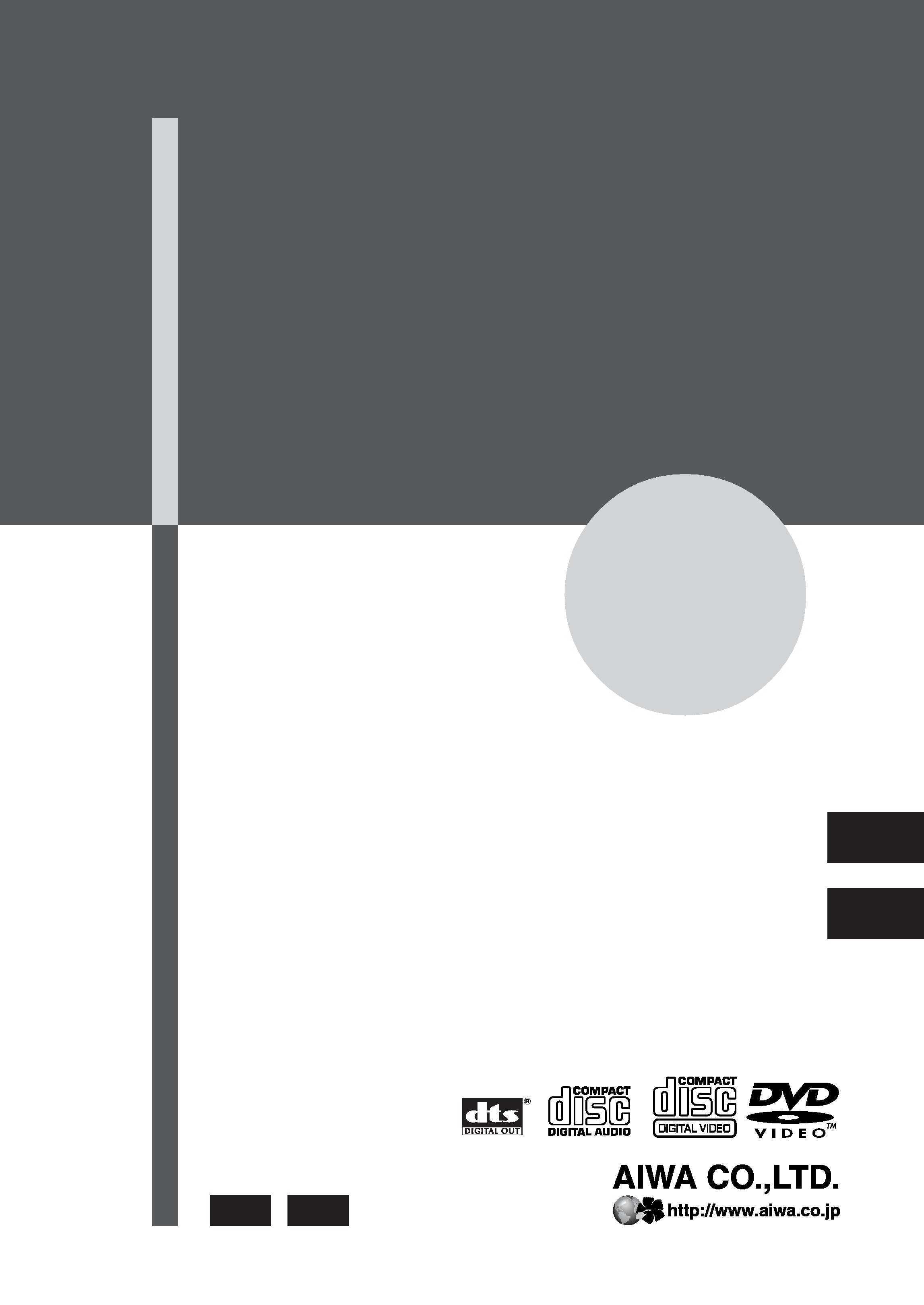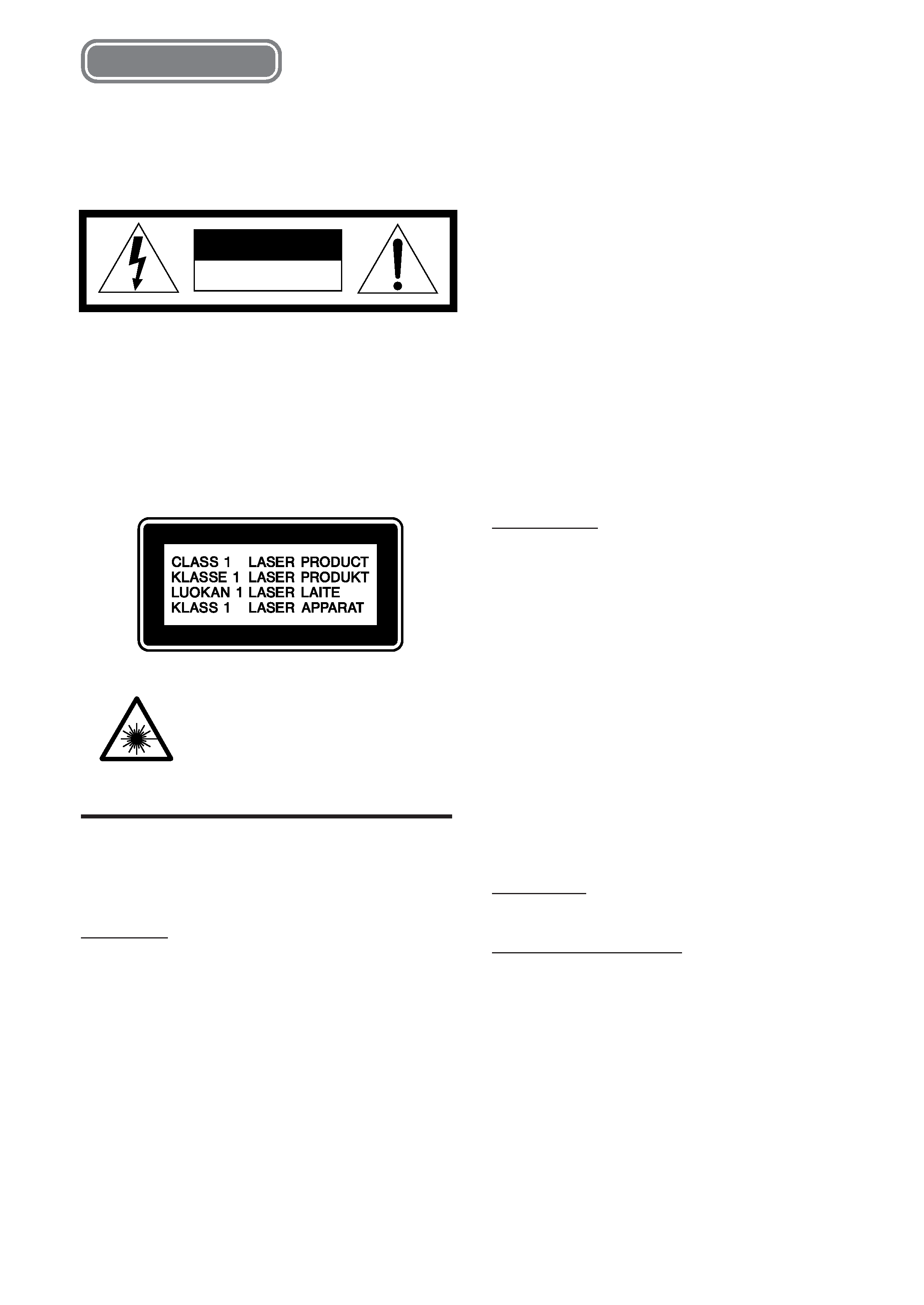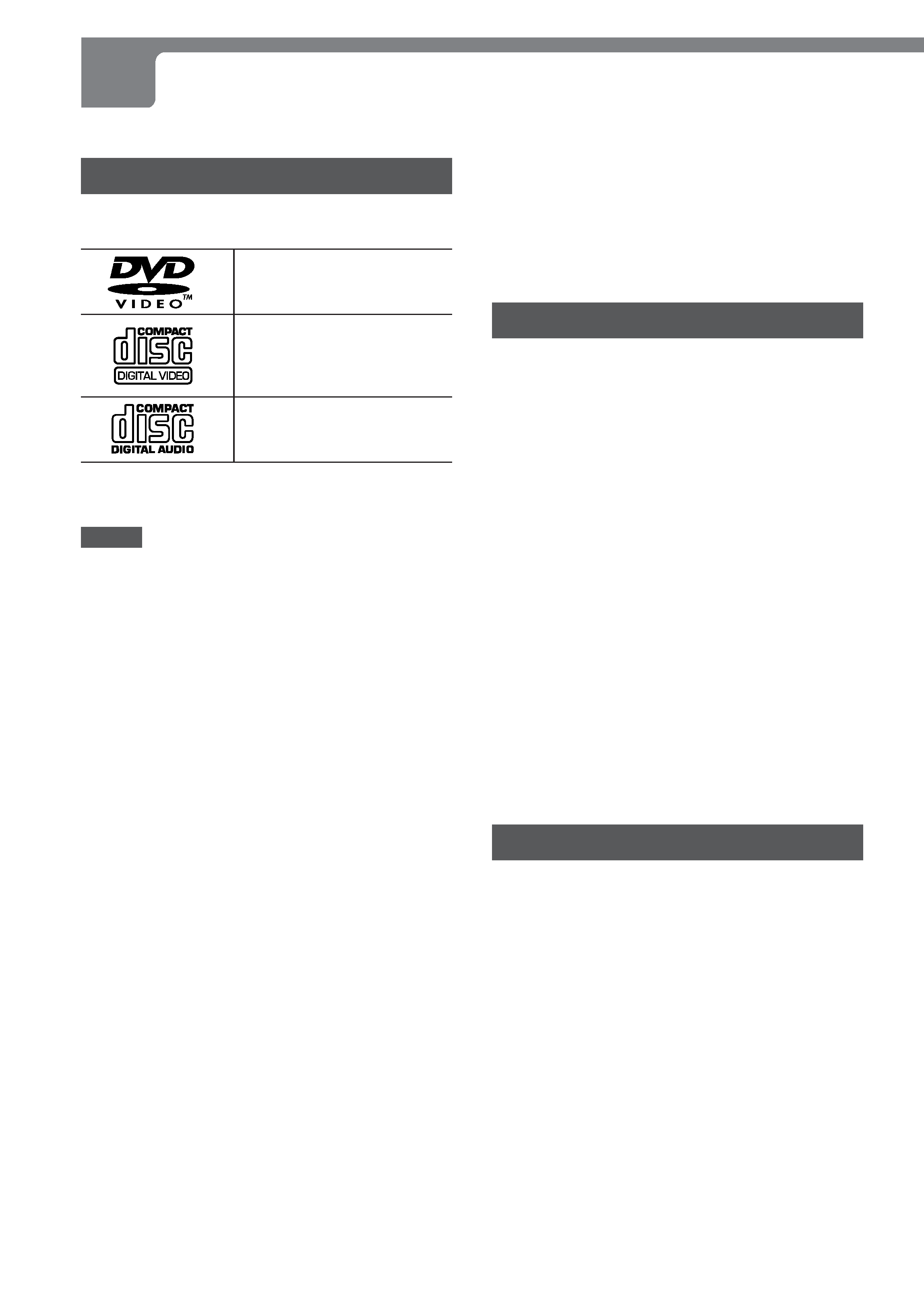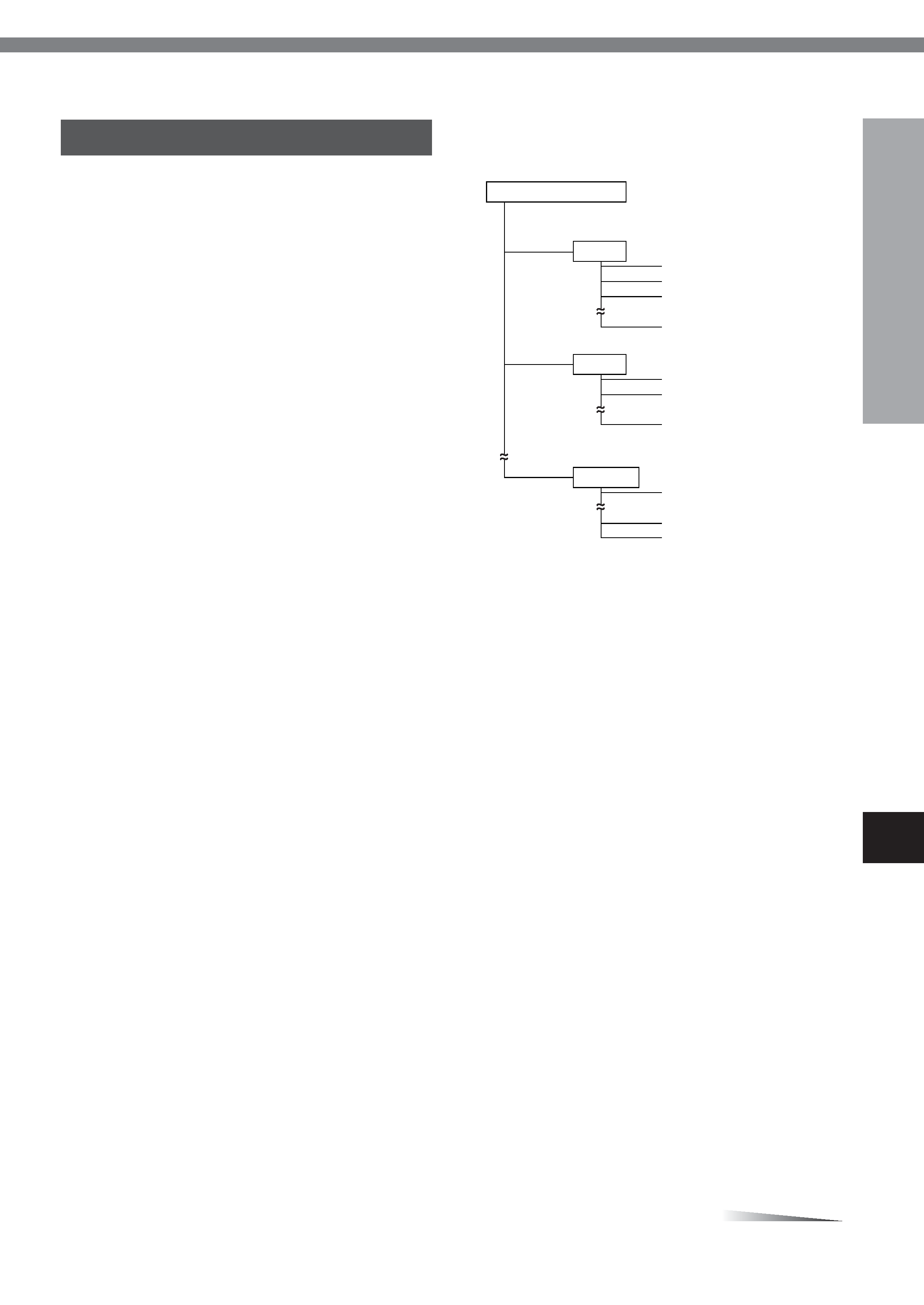
8A-AV5-902-01
010130AMK-Y-T
HEJ
DVD PLAYER
CCC
XD-DV270
OPERATING INSTRUCTIONS
CCC
En (English)
HRJ
CCC
CCC

2 ENGLISH
ENGLISH
WARNING
TO REDUCE THE RISK OF FIRE OR
ELECTRIC SHOCK, DO NOT EXPOSE THIS
APPLIANCE TO RAIN OR MOISTURE.
CAUTION
Use of controls or adjustments or performance of
procedures other than those specified herein may
result in hazardous radiation exposure.
This DVD player is classified as a CLASS 1 LASER
product.
The CLASS 1 LASER PRODUCT label is located on the
exterior.
CAUTION!
Invisible laser radiation when open
and inter locks defeated. Avoid
exposure to beam.
PRECAUTIONS
Read the Operating Instructions carefully and completely
before operating the unit. Be sure to keep the Operating
Instructions for future reference. All warnings and cautions
in the Operating Instructions and on the unit should be
strictly followed, as well as the safety suggestions below.
Installation
1Water and moisture -- Do not use this unit near water,
such as near a bathtub, sink, swimming pool, or the
like.
2 Heat -- Do not use this unit near sources of heat,
including heating vents, stoves, or other appliances that
generate heat. This unit should not be placed in
temperatures less than 5°C or greater than 40°C.
3Mounting place -- Place the unit:
- on a flat , even surface
- away from strong magnetic fields
- at least one meter away from any radios or receivers
DO NOT PLACE HEAVY OBJECTS ON THE UNIT,
OTHERWISE DISC TRAY OF THIS UNIT MAY NOT BE
OPENED.
CAUTION
RISK OF ELECTRIC SHOCK
DO NOT OPEN
4Ventilation -- The unit should be situated with adequate
space around it so that proper heat ventilation is assured.
Allow a clearance of 10 cm from the rear and the top of
the unit, and 5 cm from each side.
- Do not place the unit on a bed, rug, or similar surface
that may block the ventilation openings.
- Do not install the unit in a bookcase, cabinet, or airtight
rack where ventilation may be impeded.
5 Foreign objects and liquid -- Be careful that foreign
objects or liquid do not enter the unit through the
ventilation openings.
6Carts and stands -- The unit should be moved with
care when placed or mounted on a stand or cart.
Sudden stops, excessive force, or an uneven surface
may cause the unit or cart to fall over.
7 Condensation -- Moisture may form on the pickup lens
when:
- This unit is moved from a cold spot to a warm spot
-A heating system has just been turned on
- The unit is used in a very humid room
- The unit is cooled by an air conditioner
When this unit has condensation inside, it may not
function normally. Should this occur, leave the unit
for a few hours, then try to operate again.
Electric power
1 Power sources -- Connect this unit only to power
sources specified in the Operating Instructions, and as
marked on the unit.
2AC power cord
-When disconnecting the AC power cord, pull it out by
the AC power plug. Do not pull the cord itself.
- Never handle the AC power plug with wet hands, as
this could result in fire or electrical shock.
- Power cords should be firmly secured to avoid being
severely bent, pinched, or walked upon. Pay particular
attention to the cord from the unit to the power socket.
-Avoid overloading AC power plugs and extension
cords beyond their capacity, as this could result in
fire or electrical shock.
3When not in use -- Unplug the AC power cord from
the AC outlet if the unit will not be used for several
months or more. When the cord is plugged in, a small
electrical current continues to flow into the unit, even if
the power is turned off.
4 In case of lightning -- Immediately disconnect the AC
power cord from the AC outlet.
Maintenance
Clean the unit only as recommended in the Operating
Instructions.
Damage requiring service
Have this unit serviced by a qualified service technician if:
- The AC power cord or plug has been damaged
-A foreign object or liquid has entered the unit
- The unit has been exposed to rain or water
- The unit does not seem to operate normally
- The unit exhibits a marked change in performance
- The unit has been dropped, or the cabinet has been
damaged
DO NOT OPEN THE CABINET AND ATTEMPT TO
SERVICE THE UNIT YOURSELF.

ENGLISH
3
INTRODUCTION
En
TABLE OF CONTENTS
Introduction
Precautions ............................................................... 2
Before Use ................................................................. 4
Supported disc formats .................................... 4
Disc-related terms .............................................. 4
Types of video CDs ............................................ 4
Notes on MP3 ..................................................... 5
Handling the unit ................................................ 6
Handling discs .................................................... 6
Cleaning the unit ................................................ 6
Cleaning discs .................................................... 6
Storing discs ...................................................... 6
Notes on copyright ............................................ 6
Parts and Controls ................................................... 7
Front panel .......................................................... 7
Remote control ................................................... 8
Display window .................................................. 9
Preparations
Connections ............................................................ 10
A Connecting to a TV set only ....................... 11
B Connecting to a TV set and an amplifier
with a Digital In jack .............................. 12
C Connecting to a TV set and an audio
system ..................................................... 13
D Connecting to an AV receiver equipped
with a Dolby Digital (AC-3) or DTS
decoder ................................................... 14
E Connecting to a TV set and an AV receiver
with the Dolby Pro Logic Surround
system ..................................................... 15
Connecting to a TV set equipped with S-video
jack .......................................................... 16
Remote control ....................................................... 17
About symbols ........................................................ 17
Basic Operations
Playback .................................................................. 18
Play Back Control (PBC) ................................. 19
Digest menu ...................................................... 19
Still (Pause) ....................................................... 20
Frame advance ................................................. 20
Stopping playback ........................................... 20
Fast Forward, Reverse ..................................... 21
Slow playback ................................................... 21
Skipping ............................................................ 21
Direct skipping ................................................. 21
More Features
Mark playback ......................................................... 22
Marking .............................................................. 22
Mark playback .................................................. 22
Zooming and changing the angle ......................... 23
Zoom function .................................................. 23
Changing the angle .......................................... 23
Random and repeat playback ............................... 24
Random playback ............................................ 24
Repeating a portion between two specified
points (A-B Repeat) ................................ 24
Programmed playback ........................................... 25
Creating a 3D Surround effect .............................. 26
Changing audio soundtracks ................................ 27
Displaying and changing subtitles ....................... 28
On Screen Display (OSD) ...................................... 29
Playing Karaoke ...................................................... 30
Playing a karaoke disc .................................... 30
Adjusting microphone volume ....................... 30
Karaoke menu options .................................... 31
As Necessary
Changing setup values .......................................... 32
Basic operations .............................................. 32
LANGUAGE ....................................................... 32
SUBTITLE .......................................................... 33
AUDIO (soundtrack language) ........................ 33
TV TYPE ............................................................. 33
TV SYS ............................................................... 34
AUD OUT (Digital Audio Output) .................... 34
PASSWORD ....................................................... 35
RATING (Parent lock level) .............................. 35
OSD (On Screen Display on/off) ..................... 35
Terminology ............................................................ 36
Troubleshooting ..................................................... 37
Specifications ......................................................... 38
Features
DVD: providing a completely new dimension in video
entertainment.
· With the multi-angle function* you can select a viewing
angle of scenes shot from multiple camera angles and
recorded on the disc.
· With the parental lock function* you can prevent
playback of specified discs unsuitable for certain
audiences.
*All of the above functions are dependent on the DVD
software.
High quality digital audio and images
· Compatible with super video CDs, video CDs and
audio CDs as well as DVDs
· MP3 playback
Accessory checklist
Remote control (1)
Audio cord (1)
Video cord (1)
Operating Instructions

4 ENGLISH
BEFORE USE
Please read the following before operating the DVD player.
Supported disc formats
This DVD player can play discs with the following marks
only.
DVDs
(8 cm disc/12 cm disc)
Super video CDs (SVCDs)
Video CDs (VCDs)
(8 cm disc/12 cm disc)
Audio CDs
(8 cm disc/12 cm disc)
In addition, this unit can be played back a CD-R or CD-RW
that contains audio titles or MP3 files.
NOTES
· Depending on the conditions of the recording equipment
or the CD-R/RW disc itself, some CD-R/RW discs can
not be played on this unit.
· The unit can not play back the CD-R/RW discs
that contain no data or different kinds of formatted
data other than MP3.
· Do not attach any seal or label to either side (the labeled
side or the recorded side) of a disc.
· Do not use irregular shape CDs (example: heart-shaped,
octagonal ones). It may result in malfunctions.
Notes on color system
This unit is designed for the both PAL and NTSC color
system.
Notes on DVDs, super video CDs and video CDs
Some playback operations of DVDs, super video CDs and
video CDs may be intentionally fixed by software
manufacturers. As this player plays DVDs, super video CDs
and video CDs according to disc contents designed by the
software manufacturer, some playback features of this player
may not be available, or other functions may be added.
Also refer to the instructions supplied with the DVDs, super
video CDs and video CDs.
Some DVDs made for business purposes may not be played
on this player.
Region code of the DVD player and DVDs
This DVD player is designed and manufactured for playback
of region "3" encoded DVD software. Region code labels
appear on the labels of some DVD discs to indicate which
type of player can play those discs. Unless "3" is included in
these labels, or "ALL" appears on the DVD disc labels, those
discs cannot be played on this player. If you try to play these
discs, the message "INVALID REGION" will appear on TV
screen. Some DVD discs may not have a region code label
even though their playback is prohibited by area limits.
Note on DTS-encoded CDs
When playing DTS-encoded CDs, excessive noise will be
exhibited from the analog stereo outputs. To avoid possible
damage to the audio system, the consumer should turn
down the volume before playing back such a disc, adjust
the volume gradually, and keep the volume level low. To
enjoy DTSTM playback, an external 5.1 channel DTSTM
decoder system must be connected to the digital output of
this unit.
Disc-related terms
Title (DVD only)
The longest section of a picture or a musical piece on a DVD;
a movie for a picture piece on video software, or an album for
a musical piece on audio software. Each title is assigned a
title number enabling you to locate the title you want.
Chapter (DVD only)
Sections of a picture or a musical piece that are smaller
than titles.
A title is composed of several chapters. Each chapter is
assigned a chapter number, enabling you to locate the
chapter you want. Depending on the disc, there may be no
chapter recorded.
Track (Super video CD, video CD and audio CD)
Sections of a picture or a musical piece on a super video
CD, a video CD or an audio CD. Each track is assigned a
track number, enabling you to locate the track you want.
Scene
On a super video CD or a video CD with PBC (playback
control) functions, moving pictures and still pictures are
divided into sections called "Scenes". Each scene is
displayed in the menu screen and assigned a scene
number, enabling you to locate the scene you want.
A scene is composed of one or several tracks.
Types of video CDs
There are two types of video CD (VCD)s.
Video CDs equipped with PBC (Version 2.0)
PBC (playback control) allows you to interact with the
system via menus, search functions or other typical
computer-like operations. Moreover, still pictures of high
resolution can be played, if they are included in the disc.
Video CDs not equipped with PBC (Version 1.1)
Operated in the same way as audio CDs, these discs allow
playback of video pictures as well as sound, but they are
not equipped with PBC.

ENGLISH
5
INTRODUCTION
En
Notes on MP3
An MP3 file stores audio data compressed using MPEG1,
the audio layer-3 file-coding scheme.
In this manual, we refer to what are called "folder" and "file"
in PC terminology as "album" and "track".
Notes on playing MP3
· An MP3 track must be recorded on a disc in the format
compliant with ISO 9660. Note, however, that the unit
may not play tracks in the order they were recorded.
· The maximum allowable number of tracks and albums
in a disc are as follows:
- number of tracks :
300
- number of albums : 127
· The maximum allowable depth of nested albums is 2,
including the root album (directory).
· If a disc contains audio tracks and MP3 tracks, the unit
cannot play.
· As for a multi-session disc, the unit play only the first
session.
· The unit can play only MP3 tracks which were converted
with a sampling frequency of 44.1 kHz and a fixed bit
rate of 128 kbps.
· The unit may not play MP3 tracks recorded using a packet
writing utility.
· The unit can play only MP3 tracks having a file extension
".mp3".
· It may take 30 seconds or more before the unit can start
play of MP3 tracks, depending on the number of recorded
tracks and the complexity of the album tree.
·If you play a non-MP3 track that has the ".mp3" file
extension, you may hear some noise.
· The unit does not output digital signals while playing MP3
tracks.
·Only the following function buttons works while playing
MP3 tracks:
- PLAY c, STOP s, PAUSE a, Forward SKIP t,
Reverse SKIP r, ON SCREEN DISPLAY ON/OFF,
numbered buttons, OPEN/CLOSE.
Notes on display indications during play
· The elapsed playing time may not be displayed correctly
for MP3 tracks.
· Any names of albums and tracks are not displayed.
The order of playing back MP3
The unit only plays MP3 tracks in the following order.
Notes on creating MP3 discs
·When converting audio data to MP3
To enjoy high sound quality, create MP3 files with a
sampling frequency of 44.1 kHz and a fixed bit rate of
128 kbps.
·When creating MP3 discs
Do not store more than 127 albums in a disc. Also, keep
the total number of albums and tracks 300 or less in a
disc.
·To play tracks in the order they were recorded
1. Use a writing software capable of recording MP3 tracks
(files) in numerical and alphabetical order. For details
on using the software, refer to the operating instructions
supplied with the software.
2. Use only one album. (Do not create a sub-album within
an album.)
3. Include a two or three-digit number at the beginning
of each album or track name so that the albums and
tracks are played in order.
<example of recommended names>
01XXXXX.mp3
02XXXXX.mp3
03XXXXX.mp3
04XXXXX.mp3
05XXXXX.mp3
<example of names not recommended>
1XXXXX.mp3
5XXXXX.mp3
10XXXXX.mp3
15XXXXX.mp3
20XXXXX.mp3
(Numbers at the beginning have different digit number. The
tracks will not be played in this order but played in the order
of "1", "10", "15", "20" and "5".)
Root Directory(Album)
[Order of Playback]
Album 1
Track 1
[ 1 ]
Track 2
[ 2 ]
Track 3
[ 3 ]
Track 20
[ 20 ]
Album 2
Track 1
[ 21 ]
Track 2
[ 22 ]
Track 12
[ 32 ]
Album 127
Track 1
[ 291 ]
Track 9
[ 299 ]
Track 10
[ 300 ]
CONTINUE
